Did you know that the human brain processes visual information 60,000 times faster than written text? This means that what we see can immediately make a strong impression, including your glasses. Glasses are not just for seeing better; they also reflect your style. They are one of the first things people notice about you. The right glasses can improve your look, make you feel better about yourself, and help you show who you are non-verbally.
Choosing the right glasses is not just about liking a frame. Your eyewear should fit your face shape, just as your clothing should fit your body shape. If your face is round, square, oval, or heart-shaped, some frames will look better on you than others. The right frames can make you look more balanced and improve your overall look.
In this post, we will examine how knowing your face shape can help you pick the best glasses. These glasses will improve your vision and style. Let’s start by understanding how to find the perfect pair of glasses!
Contents
- 1 Decoding Your Face Shape: The Foundation of Eyewear Selection
- 2 Frame Styles That Flatter Each Face Shape
- 3 Materials and Colors: Enhancing Style and Comfort
- 4 Fashion Trends in Eyewear: Staying Stylish in 2025
- 5 FAQ: Your Questions About Choosing Glasses for Your Face Shape
- 6 Final Thoughts: Finding Your Perfect Pair of Glasses
Decoding Your Face Shape: The Foundation of Eyewear Selection
Choosing the right glasses is like choosing clothes that suit your body shape. You need to look for frames that match the shape of your face. When your glasses fit well, they highlight your best features, helping you look neat and stylish.
Finding your face shape helps you pick glasses that improve your vision and make your look more balanced. Self-awareness and some easy measurements can help you figure out your face shape. Then, you can start looking for the best pair of glasses.
Identifying Your Face Shape: A Step-by-Step Guide

Here’s a detailed, step-by-step method to help you determine your face shape:
- Gather Your Tools: You’ll need a mirror, soft measuring tape, and a pen and paper to record measurements.
- Measure Your Face: Start by measuring four key areas of your face:
- Forehead width: Measure the widest part of your forehead, usually around your eyebrows.
- Cheekbone width: Measure from one cheekbone to the other, across the top of your cheeks.
- Jawline: Measure along your jawline from one end to the other, just below your ears.
- Face length: Measure from the top of your forehead to the bottom of your chin.
- Visual Cues: As you study yourself in the mirror, note the proportions of your face. Is your face more angular or round? Do you have a strong jawline or soft curves? Pay attention to these details, as they will help you match your measurements with the visual characteristics of specific face shapes.
- Determine Your Face Shape: Compare your measurements and visual cues with the six primary face shapes outlined below. While you may not fit perfectly into one category, identifying the dominant features will help guide your choice of eyewear.
The Six Primary Face Shapes and Their Characteristics

Each face shape has its own distinct features, and understanding these characteristics will make it easier for you to select the best glasses for your face. Here’s a breakdown of the six primary face shapes:
- Round Face
- Characteristics: A round face typically has softer, fuller cheeks, a rounded chin, and equal width and length. The width and length of the face are almost the same, giving it a circular appearance.
- Key Features: Full cheeks, rounded jawline, lack of sharp angles.
- Oval Face
- Characteristics: An oval face is slightly longer than it is wide, with a forehead that’s slightly wider than the chin. The jawline is softly rounded, and the cheekbones are prominent.
- Key Features: Balanced proportions, gently curved features, slightly elongated face.
- Square Face
- Characteristics: A square face features a strong, angular jawline and a broad forehead. The width of the forehead, cheekbones, and jawline are all similar, giving the face a more angular and structured look.
- Key Features: Defined jawline, strong cheekbones, angular features.
- Heart Face
- Characteristics: The heart-shaped face is characterized by a broad forehead and cheekbones that narrow to a small, pointed chin. The upper portion of the face is wider, and the lower portion is more tapered.
- Key Features: Widest at the forehead, narrow chin, prominent cheekbones.
- Diamond Face
- Characteristics: High cheekbones, a narrow forehead, and a pointed chin distinguish a diamond face shape. The face appears angular, with the cheekbones being the widest point.
- Key Features: High, wide cheekbones, narrow forehead and chin, angular features.
- Oblong Face
- Characteristics: An oblong face is longer than wide, with a more pronounced chin and longer cheekbones. The forehead, cheekbones, and jawline are of similar width.
- Key Features: Long face, angular features, slightly elongated proportions.
Frame Styles That Flatter Each Face Shape
Choosing the right frame style is important in finding glasses that highlight your natural features. For example, picking clothes that suit your body shape and selecting eyewear that fits your face shape can greatly improve your look. By thinking about the different qualities of each face shape, you can find frame shapes that create balance, contrast, and harmony.
In this section, we will examine different frame styles that suit each face shape. Round faces look good with sharp styles, while oblong faces need width in their frames. We will also examine the best materials and colors for each face shape.
Round Faces: Adding Angles and Structure
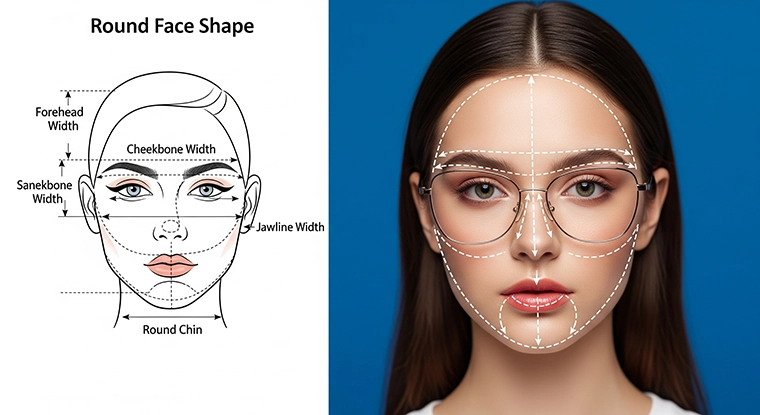
Softer curves, full cheeks, and a rounded jawline characterize a round face. It’s important to choose frames that add definition and structure to balance these features. Here’s what works best for round faces:
- Frame Styles: Angular and rectangular frames are perfect for adding contrast to the softness of a round face. Look for frames with sharp lines, such as square or geometric styles, which create an illusion of length and definition.
- Materials & Colors: Choose metal or acetate for a sleek, structured look. Darker colors such as black, tortoiseshell, or deep hues create contrast and define the face. Avoid overly round frames, as they can exaggerate the natural roundness of your face.
By selecting frames with strong lines and angular shapes, you can achieve a flattering balance that highlights your features while adding some definition.
Oval Faces: Embracing Versatility
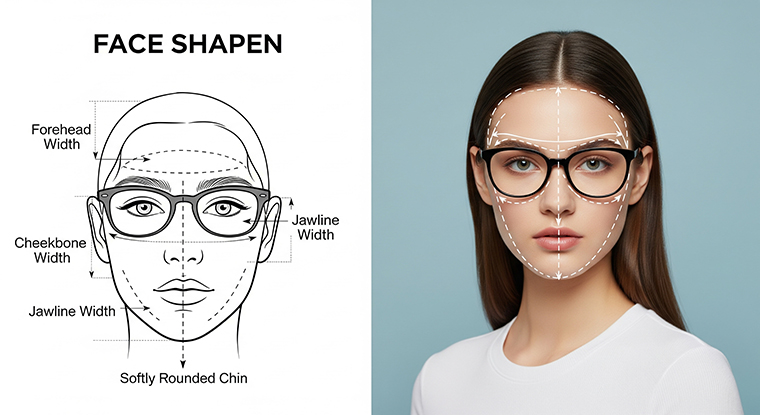
Oval faces are versatile and can pull off various frame styles thanks to their balanced proportions and gently rounded contours. Here are tips to choose the best glasses for oval faces:
- Frame Styles: Almost any frame style works for oval faces, but the goal is maintaining balance and proportion. Go for frames as wide as the broadest part of your face to avoid elongating it further. Rectangular, square, and round frames all work well, as long as they don’t overwhelm your natural features.
- Tips: To keep things balanced, avoid too large or too small frames. For a polished look, choose frames that complement the natural symmetry of your face, such as medium to large frames that aren’t overly bulky.
Oval faces enjoy the freedom to experiment with different frame styles, so choose frames that enhance their natural balance while adding personality to their looks.
Square Faces: Softening Sharp Angles
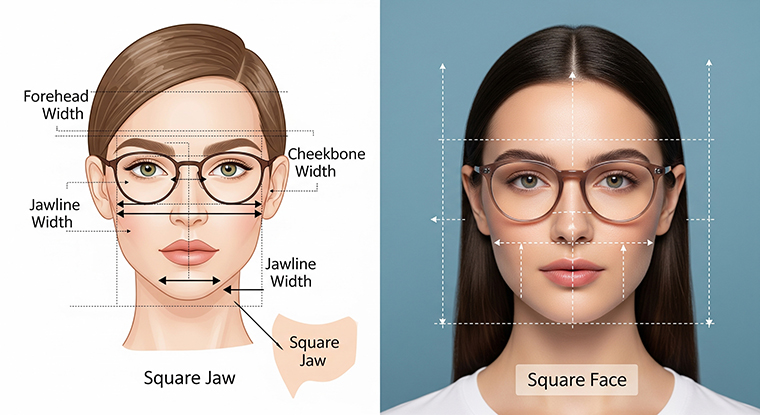
A square face has strong, angular features, a broad forehead, and a defined jawline. Consider the following tips to choose the top glasses styles for square faces:
- Frame Styles: Round or oval frames are ideal for square faces, as they contrast with the sharpness of the jawline and forehead. These softer shapes create balance by adding curves to the face’s angularity.
- Frame Sizes & Colors: To add harmony to the face, go for slightly larger or rounder frames. Lighter or translucent colors work well, as they help soften the features. Avoid boxy, angular frames, as they can emphasize the sharpness of the face.
The key to flattering a square face is to choose frames that add curves and softness, allowing your natural features to shine without being overwhelmed by sharp lines.
Heart-Shaped Faces: Balancing the Forehead and Chin
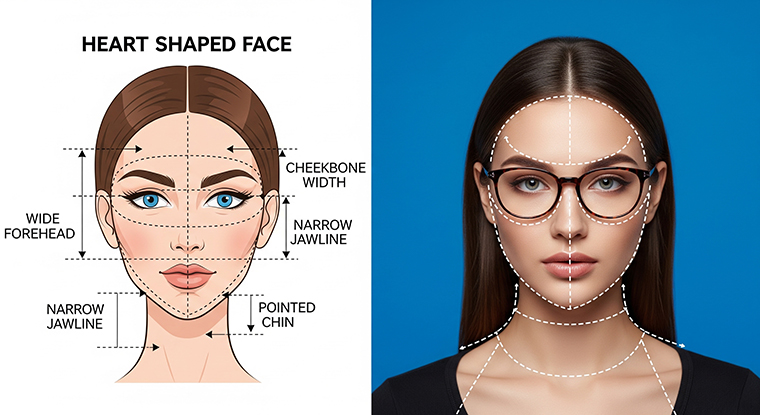
Heart-shaped faces are wider at the forehead and narrow at the chin, creating a striking, inverted triangle face shape. The goal is to balance the proportions and draw attention away from the wider upper half of the face. Best frames for a heart-shaped face:
- Frame Styles: Frames that draw attention downward, such as bottom-heavy styles or wider frames, help balance the forehead and chin. With their upward swooping corners, cat-eye frames work beautifully by emphasizing the eyes and creating balance. Aviator or round frames also help to soften the angles of your face.
- Frame Styles & Colors: Lighter or softer colors, like light pink, gold, or silver, complement the delicate features of a heart-shaped face. Avoid overly thick frames at the top, as they can accentuate the width of your forehead. Choose slightly narrower frames at the top and wider at the bottom for an aesthetically pleasing balance.
The right frames for a heart-shaped face will help redirect attention from the forehead and create a more proportional appearance from top to bottom.
Diamond Faces: Accentuating the Cheekbones
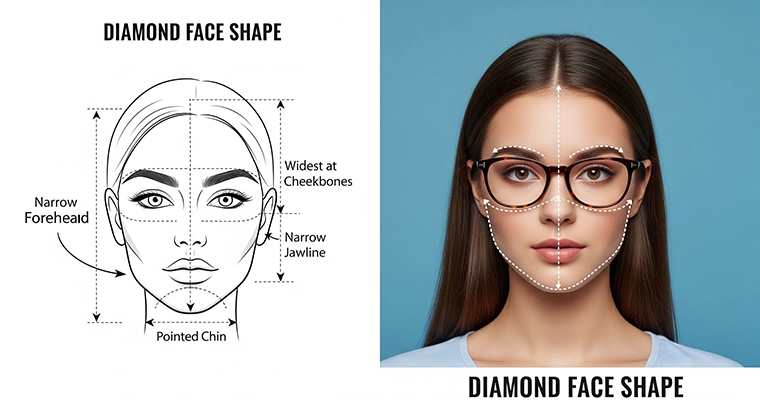
Diamond-shaped faces are marked by high cheekbones, a narrow forehead, and a pointed chin. The key to flattering a diamond-shaped face is emphasizing the cheekbones while softening the chin and forehead.
- Frame Styles: Frames that accentuate the cheekbones and soften the angularity of the chin work best. Oval or rounded frames and frames with a slightly wider bottom can highlight the cheekbones and bring balance to the narrow chin. Frames with detailing along the browline also work well to bring attention to the eyes.
- Colors & Materials: Dark browns, tortoiseshell, or jewel tones complement the features of a diamond face. Choose materials like acetate, which provide structure while highlighting the cheekbones.
For diamond-shaped faces, frames that enhance the upper part of the face while softening the lower part can create a flattering, well-balanced look.
Oblong Faces: Creating the Illusion of Width

Oblong faces are longer than wide, with high cheekbones and a narrow chin. The goal is to create the illusion of width and balance the face’s elongated proportions.
- Frame Styles: Choose frames that add width to the sides of your face to create the illusion of a shorter face. Square, rectangular, or oversized glasses create balance by emphasizing the width. Horizontal frames, especially those with bold, straight lines across the brow, can also add the necessary contrast to elongate the face.
- Tips on Placement & Size: Frames that sit higher on the nose and cover more of the face’s width help shorten the overall length of the face. Avoid long, thin frames that will further elongate the face. Choose larger, more substantial frames to break up the length and add balance.
For oblong faces, the goal is to create the visual effect of a wider, more proportionate face by choosing frames that emphasize width and avoid exaggerating length.
If you’re unsure which frames best complement your face shape, you can consult experts in the field to help guide your decision. They’ll provide personalized advice and help you choose the best glasses for your face shape, ensuring both style and comfort.
Materials and Colors: Enhancing Style and Comfort
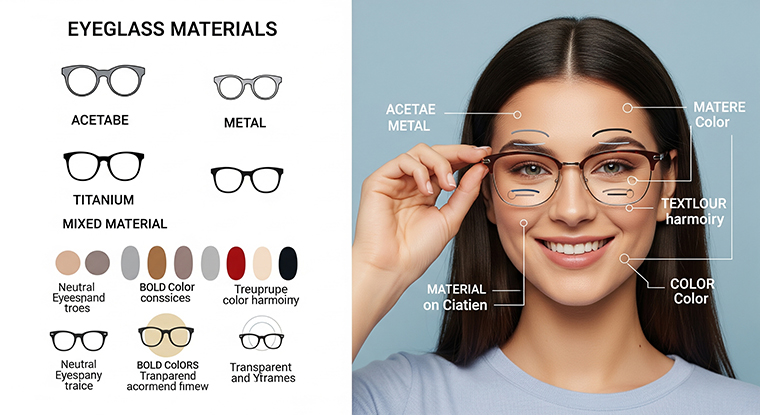
When choosing glasses, the frame material and color significantly shape your overall look and style. The right material can influence your glasses’ comfort, durability, and weight. At the same time, color can enhance your complexion, reflect your personality, and even influence how others perceive your face shape.
In this section, we’ll explore the different frame materials and how they affect the fit and feel of your glasses. We’ll also discuss how to choose the perfect frame color to complement your skin tone and personal style.
Frame Materials: Weighing the Options
There are several popular frame materials, each with unique benefits. Choosing the right material can enhance the durability and comfort of your glasses and influence their appearance.
- Acetate: Acetate is a popular frame material known for its lightweight feel and wide range of colors and patterns. It’s made from plant-based fibers, making it a more eco-friendly option. Acetate frames are comfortable and flexible but can be thicker and more statement-making than other materials. These frames are also highly durable and resistant to scratches, making them a great long-term investment.
- Metal: Metal frames offer a sleek, minimalistic appearance and are known for their durability and strength. They are typically lighter than acetate, making them a comfortable choice for those who need glasses for long periods. Metal frames come in various finishes, from matte to shiny, and can be adjusted for a more personalized fit. However, metal frames may be more prone to bending or breaking if mishandled, and they often come in fewer color options than acetate.
- Titanium: Titanium frames are among the most durable and lightweight options available. They are resistant to corrosion and wear, making them a great option for those who need sturdy glasses for daily use. Titanium is also hypoallergenic, which is perfect for individuals with sensitive skin. While titanium frames can be more expensive, their long lifespan and comfort make them a worthwhile investment.
- Wood and Bamboo: Wood and bamboo frames are a fantastic choice for those seeking an eco-friendly and unique look. These lightweight materials offer natural, rustic charm, though they tend to be less adjustable and can be prone to wear over time. Wood frames also have a distinct texture that can add personality to your glasses.
Comfort & Durability: While metal and acetate are the most common materials, it’s important to consider your specific needs regarding comfort and durability. Titanium might be the best choice if you have a more active lifestyle or need glasses that will withstand daily wear. For those looking for a more fashionable, statement-making look, acetate or wood frames could be the way to go.
Color Choices: Complementing Skin Tone and Personal Style
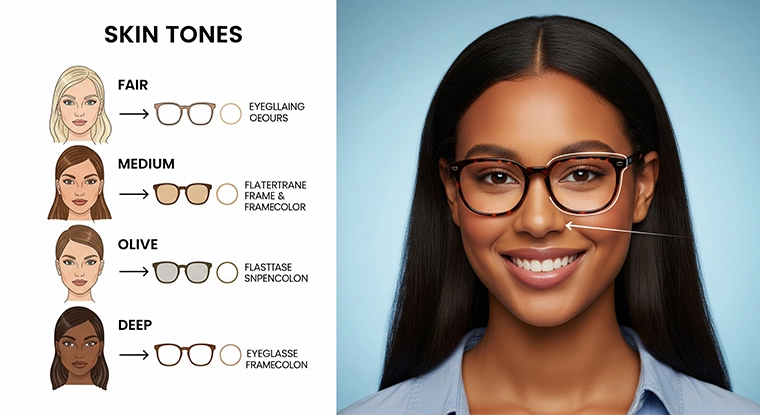
The color of your frames can do more than just reflect your personal style—it can also complement your skin tone, enhance your facial features, and influence how your face shape is perceived. When selecting frame colors, it is important to choose shades that harmonize with your complexion while also reflecting your individuality.
- Skin Tone Considerations: Understanding skin tone is key to choosing the right frame color. Generally, people with warm undertones (golden, yellow, or peachy hues) look great in earthy tones like browns, tortoiseshell, gold, and warm greens. Those with cool undertones (pink, red, or blue hues) tend to suit cooler tones like silver, black, blue, or dark purple. For neutral undertones, warm and cool tones work well, giving you flexibility to experiment with various frame colors.
- Personal Style: Color also reflects your personality and style preferences. Bold colors like red, blue, or green can make a statement and show off your fun, adventurous side. More muted tones like black, gray, and brown are timeless, sophisticated, and versatile, ideal for individuals who prefer a more classic or professional look. Tortoiseshell frames, which combine warm browns and blacks, offer a versatile and stylish option that can complement many different outfits and occasions.
- Influencing Face Shape Perception: Color can also affect how your face shape is perceived. Darker colors, such as black or deep brown, can define the face and make it appear smaller, which is ideal for those with larger or broader features. Lighter colors, such as pale gold or clear, tend to soften the face and create a more delicate look, often flattering for those with sharper angles. Bold or bright colors can also draw attention to your eyes, enhancing your facial features, while softer colors blend efficiently into your overall look.
Fashion Trends in Eyewear: Staying Stylish in 2025

In 2025, eyewear is more fashion-forward than ever. Here are the hottest frame styles making waves this year:
- Geometric Frames: Bold angular shapes like octagonal and hexagonal frames are gaining popularity, adding structure to round or square faces.
- Oversized Frames: Big, dramatic frames in cat-eye or square shapes make a strong statement. Ideal for oval and heart-shaped faces, they balance proportions and add flair.
- Transparent Frames: Clear or semi-transparent frames offer a minimalistic, versatile look that works for any face shape and blends efficiently with your style.
- Sustainable Frames: Eco-friendly materials such as recycled plastics and bio-based options are becoming a key trend, offering durability and style.
- Bold Color Accents: Frames with bright pops of color or color-blocking are in, perfect for adding a playful twist to your look.
Celebrity Eyewear Inspirations

Celebrities are always leading the way in eyewear fashion. Here’s how to adapt their iconic styles to your face shape:
- Cat-Eye Frames: Worn by Taylor Swift and Sofia Vergara, cat-eye frames work best on heart-shaped faces, adding drama and balance.
- Round Glasses: Popular with Harry Styles and John Lennon, round glasses soften square faces and add a vintage touch.
- Bold Square Frames: Celebrities like Rihanna love bold square frames, perfect for adding definition to round faces.
- Aviator Glasses: A classic look favored by Gigi Hadid, aviators are flattering on almost every face shape, especially oval and square faces.
- Retro Frames: Retro round and oval frames, worn by stars like Zooey Deschanel, help soften angular features, perfect for square or diamond faces.
FAQ: Your Questions About Choosing Glasses for Your Face Shape
How do I find the perfect pair of glasses?
Start by identifying your face shape. Then, choose frame styles, materials, and colors that enhance your features and reflect your personal style. Comfort and fit are key!
How do I determine my face shape for glasses?
Measure your face’s key features (forehead, cheekbones, jawline, and face length) and compare them to common face shape categories: round, oval, square, heart, diamond, or oblong.
How do I choose a pair of spectacles?
Consider your face shape, style preferences, and comfort. Select frames that balance your features, complement your skin tone, and offer a comfortable fit.
Which face shape is best?
While the Oval is considered the most ideal face shape (it is scientifically proven that symmetry = beauty), each face shape has its own unique beauty. The key is to choose frames that balance your features and complement your natural lines.
Is there an app to find glasses that fit your face?
Yes, apps like VirTry, Warby Parker’s Home Try-On, GlassesUSA allow you to virtually try on glasses using a photo of your face to find the perfect fit and style.
Final Thoughts: Finding Your Perfect Pair of Glasses
Choosing the right glasses is a skill that combines usefulness and style. Knowing your face shape allows you to pick frames that help your eyesight and show off your natural features. Whether your face is round, oval, square, heart-shaped, diamond-shaped, or long, the right eyewear can change how you look and feel.
Think about your face shape, materials, and colors that match your skin tone and style. Light materials, like plastic or metal, feel comfortable. Eco-friendly choices fit well with caring for the environment. Bright colors or clear frames can be stylish. On the other hand, softer tones are more flexible.
The best pair of glasses is one that feels good, fits you well, and makes you feel confident. Spend time looking at different frames and trying out shapes to find the ones that match who you are. With these tips, you can find glasses that boost your style and highlight your best features.
If you have any questions or need advice on choosing the perfect glasses for your face shape, feel free to leave a comment below! Our experts are here to help, and we’d love to hear from you. Let’s find the ideal pair together!

